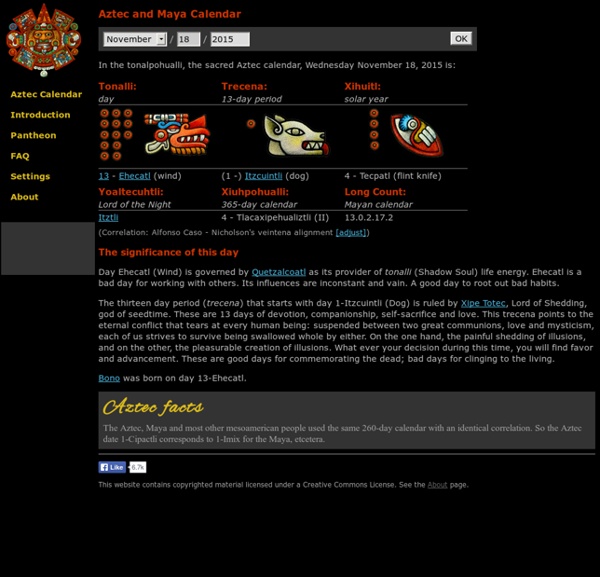



LA UAEH ofrece el curso "Religión, cosmovisión y naturaleza en Mesoamérica: el caso mexicano" (azteca), en su campus de Salamanca La Universidad Autónoma del Estado de Hidalgo, institución mexicana de educación superior cuyos antecedentes se remontan a 1869, y que actualmente es de las universidades con un mayor desarrollo en México, inicia actividades académicas en su sede de Salamanca con este curso que tendrá lugar del 16 al 27 de septiembre. El objetivo general del curso, que tendrá lugar del 17 al 27 de septiembre en Salamanca, es brindar, centrándose en el caso mexica o azteca, una visión general de las sociedades mesoamericanas (prehispánicas), a través de sus concepciones, y en particular, a través del sistema de aprehensión del universo que hoy llamamos cosmovisión, sistema del cual la religión es una parte fundamental. El curso constará de 10 sesiones abordando los siguientes temas: 1. OrganizaciónJuan Manuel Camacho BertránRector Enrique Gerardo Macedo OrtizSecretario General María Teresa Pantoja SánchezCoordinadora de la División de Docencia Víctor Manuel Ballesteros GarcíaCoordinador
Aztec Religion - AZTEC GODS - Aztecs of Mexico History AZTEC RELIGION AZTEC STUDENT RESEARCH GUIDE (C)1997-2005 (Thomas H. Frederiksen) All rights reserved The following major Deities have been removed from this larger work and placed into their own section TITLED MAJOR DEITIES, along with their corresponding footnotes: TEXCATLIPOCA, QUETZALCOATL, ZIPE TOTEC, TLALOC, XOCHIQUETZAL, and HUITZILOPOCHTLI. COLNAHUACATL- "The One From the Twisted Region" Wife is unknown and as the name may represent, this deity resided in one of nine hells(*9) told in Aztec mythology. AMAPAN- "Patron of the Ball" "Ball Court Deity" Along with Uappatzin, these two deities presided over the ball game(*10) and various ceremonies associated with the game itself which were conducted in Tenochtitlan. AMHIMITL -"Dart of Mixcoatl" Old Chichimec (*11) god from the ancient homeland of the Mexica in Aztlan. ____________________ 9 There are several books in print that detail the Aztec view of afterlife. 11 The Chichimec are sometimes referred to as Mimixcoa. 25 Boone p. 200.
The Aztec Templo Mayor: a symposium ... Feeding the gods: Hundreds of skulls reveal massive scale of human sacrifice in Aztec capital The priest quickly sliced into the captive's torso and removed his still-beating heart. That sacrifice, one among thousands performed in the sacred city of Tenochtitlan, would feed the gods and ensure the continued existence of the world. Death, however, was just the start of the victim's role in the sacrificial ritual, key to the spiritual world of the Mexica people in the 14th to the 16th centuries. Priests carried the body to another ritual space, where they laid it face-up. Armed with years of practice, detailed anatomical knowledge, and obsidian blades sharper than today's surgical steel, they made an incision in the thin space between two vertebrae in the neck, expertly decapitating the body. Using their sharp blades, the priests deftly cut away the skin and muscles of the face, reducing it to a skull. Eventually, after months or years in the sun and rain, a skull would begin to fall to pieces, losing teeth and perhaps even its jaw.
The macuahuitl was a sword with obsidian blades used mostly by the Aztecs. It was sharp enough to decapitate a man, and even a horse Since ancient days, people have developed sophisticated weapons to fill their arsenals. In ancient Egypt, the khopesh was a notoriously deadly sword on the battlefield. A khopesh would typically be cast out of a single piece of bronze that was quite heavy, and it looked like a cross between a battle ax and a sword. Even Ramses II is portrayed as wielding one of these. A Japanese officer of the Edo era would make great use of a sodegarami (the word itself means “sleeve entangler”). This weapon looked like a spiked pole, and it allowed the officers to confront any antagonist with a quick twist, bringing the attacked person to the ground but not necessarily inflicting severe wounds. When it comes to the Aztec warriors, perhaps their best asset on the battlefield was the macuahuitl. A modern re-creations of a ceremonial macuahuitl made by Shai Azoulai. When Cortés arrived in Central America, he certainly witnessed the strength of the Aztecs on the battlefield.
AZTEC COSMOLOGY Organization: Alexa Crawls Starting in 1996, Alexa Internet has been donating their crawl data to the Internet Archive. Flowing in every day, these data are added to the Wayback Machine after an embargo period. The Wayback Machine - The Aztecs = (the Mexicaand 6 other tribes all speaking the language Nahua) came from the north; from Aztlan where they had emerged from Chicomoztoc (7 Caves) -- they were one of seven Nahua speaking tribes; Acolhua, Chalca, Tepaneca, Tlalhuica, Tlaxcalteca, Xochimilca, Mexica. Mexica left Aztlan, migrated to Valley of Mexico; settled, sometime after l25O A.D., in Chapultepec (near the Western shore of the Lake of Texcoco). In l3l9 they were captured by their neighbors and expelled from Chapultepec. CREATION - originally there were two primordial deities – Ometecuhtli ("Lord of Duality") and Omecihuatl ("Lady of Duality") 4) Huitzilopochtli (Blue Tezcatlipoca) 1.
returns pictures as well as info by bertpiedmont Dec 2